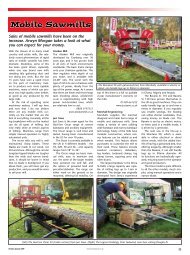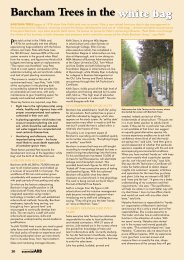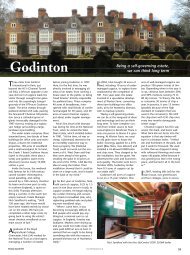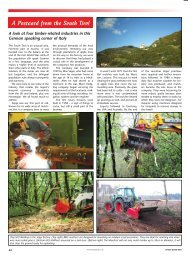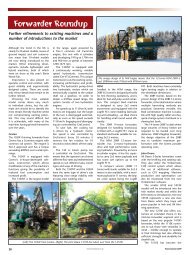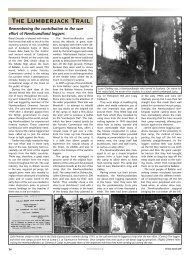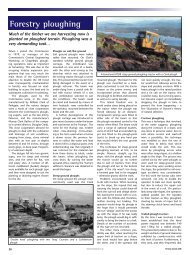Create successful ePaper yourself
Turn your PDF publications into a flip-book with our unique Google optimized e-Paper software.
<strong>TreeAbility</strong>is making it workMeeting any start-up business in arb is excitingand refreshing, especially one that knows exactlywhere it is going and is run by people who havecome into the business from an entirely differentbackground. This fledgling company has alreadyput down strong roots in and around Sevenoaksin north west Kent in what are clearly not thevery best economic conditions to venture into themarket. Dr Terry Mabbett visited <strong>TreeAbility</strong> tofind out more.Nick Winram felling the giant redwood.Now comes the hard part for the giantredwood.The giant redwood is almost ‘done anddusted’.With a sound company ethos and a firmcustomer base already secured, 90-day-old<strong>TreeAbility</strong>, jointly owned by Nick Winram and LouiseCurry, domestic as well as business partners, is alesson in having the courage to take the plunge. Nickand Louise developed their initial careers in the City ofLondon, attaining senior management positions – Nickas a business analyst in database systems and Louise inproperty and housing management.Nick takes the ‘arb’ plungeNine years ago, with just a winter’s casual work foran arborist friend in his home town of Darlington inCounty Durham still fresh in his mind, Nick gave up hisposition in the City of London to enter the arb industry.After first completing his RFS Certificate of Arboriculture(with distinction) he joined Bartlett Tree Experts at thecompany’s Radlett (Hertfordshire) office.After just 12 months as a climbing arborist Nick waspromoted to area manager based at Sevenoaks in Kent.Nick’s previous management experience clearly helpedhim in his speedy rise up the arb management ladderand made him well suited to managing crews anddetailing quotes. The downside for Nick was spendingall day looking at trees when what he really wanted todo was to work on them, his real underlying passion.So he left Bartlett Tree Experts and joined ‘Down toEarth’, a well-established arb company covering theSevenoaks area of Kent and beyond (see essentialArbIssue 29). Nick freely admits how this was a strategic‘step down’ to reconnect with hands-on tree work beforeclimbing up again within Down to Earth, or starting hisown company.Nick spent three and a half years with Down to Earthmaking crew leader in no time at all. “However, withthe imminent arrival of baby Heidi (now one year old),it was the time for us to make a complete re-appraisal ofour working lives,” said Louise.40
Left: The council gave the goaheadto fell and remove thisdiseased silver birch in spite ofan existing TPO.Above: Nick Winramdismantling the diseased silverbirch.Right: Nick and Louisewith the Bandit 65 andclearly a soundpurchase.<strong>TreeAbility</strong> is born<strong>TreeAbility</strong> was born some nine monthsafter the arrival of Heidi. On completionof her maternity leave Louise left behindwhat was by now a very senior position inhousing management (assistant director withresponsibility for 20,000 properties and a130-strong workforce) to become full-time jointpartner in <strong>TreeAbility</strong> with Nick. With Nick’sdecade of practical arb experience and a TechCert Arb gained from Merrist Wood alongthe way, and supported by Louise’s strongmanagement experience and enthusiasm, thisbrand new company ventured into the leafylanes of northwest Kent.On the day of our visit Nick and Louise wereworking in the large tree- and hedge-flankedgarden of a regular client in a village outsideSevenoaks, clearly making a neat job oftrimming a high holly hedge having alreadydone the same for an immaculate-lookingbeech hedge nearby. This particular customerwas one of the first on board knowing Nickand Louise as fellow members of SevenoaksHockey Club.Now is not perhaps the easiest time to startup in arb, even in the wealthy and tree-richcommuter communities of northwest Kent andnearby northeast Surrey, traditionally regardedas one of southeast England’s stockbrokerbelts.Securing a customer baseI asked Louise and Nick what type of clientsthey had on board and what they were doingto secure a wider customer base for thefuture. “We already have a number of regularhouseholder customers in the Sevenoaks areaand further afield into southeast London,Surrey and even Sussex,” said Louise.“We have carried out work for SevenoaksDistrict Council including felling and removingdead elm poles,” said Nick, explaininghow these continually arise as root suckersfrom residual root systems of mature elmsfelled around forty years ago when Dutchelm disease (DED) hit the many hedgerowelms in this area. As soon as the poles reachsome three metres tall with a sufficiently wellformedbark, elm beetles carrying the DEDfungal pathogen invade and infect the wood.The disease rapidly girdles the stems whichbecome brittle and shatter, falling into roadsand lanes to create traffic hazards.Nick and Louise clearly find hedging asupremely satisfying job and speak warmlyabout a big hedging job carried out forSevenoaks Hockey Club where they reduceda 12–13 metre Leylandii hedge down to 10metres. “It couldn’t be lower than 10 metres,”said Nick, “because the floodlights usedfor evening games in winter would disturbresidents in neighbouring properties.”“We have also carried out significantindividual tree work,” said Louise, “includingthe dismantling of two English oak trees visiblyinfected with Ganoderma, with brackets on thebuttresses on one side clearly playing a majorsupporting role for the tree.”“There were also visible pockets of decaybetween these buttresses,” said Nick, addinghow they had just recently cut down andremoved a giant redwood stem remainingafter the tree was struck by lightning 10 yearspreviously. The stem, which was 15 feet highand 9 feet in diameter (at breast height), wascut down using a Husqvarna 395 fitted with a36-inch bar.Planting for the futureAny savvy business, whether new orestablished, knows the importance of makingsure that ‘doors open as others close’ so Iasked Nick and Louise what they were doingto broaden their customer base. The answerwas intriguing because instead of targetingmature tree work which is the answer youwould expect from most arborists, Nick andLouise are looking much further back along theline to sow their seeds of success.Below: The Bandit65 disc chipper inaction.41
Feature: <strong>TreeAbility</strong>“We enjoy everything about arb,” said Louise, “including treeplanting as well as hedging.” To this end they have been informinglocal schools and community groups about the Woodland Trust’s freeof charge ‘themed’ tree packs (30, 105 and 420 trees) including‘small copse’, ‘small hedge’ and ‘wildlife’ packs. “We offer ourservices free of charge and include advice on which packs to choosefor particular sites and will provide free mulch and feeding. And wewill be there in a supervisory role for the tree planting,” she said.Maybe it’s a long shot but it sounds good to me because as a generalrule ‘goodwill’ generates more of the same.Equipment <strong>profile</strong>I was interested to see what sort of saws this new company wasusing. Nick showed me his ground saw combination comprising aHusqvarna 357 and a lightweight Stihl MS 170 alongside a Stihl MS200 top-handle climbing saw. The most recent acquisition with whichthey are clearly very pleased is the Husqvarna 395 with 36-inch and25-inch bars, with Nick citing “Plentiful power, prompt, trouble-freestarting and smooth running” as the key positive points.Hedge trimming is not every arborist’s cup of tea but Nick andLouise have clearly thrown themselves into this task with enthusiasmciting both the artistic and aesthetic satisfactions gained. Hedgingequipment currently at their disposal is a Stihl KM 90 R long-reachhedgecutter, a Stihl HS 86 R short-reach hedgecutter and a Stihl HS86 T specifically for the fine trimming of conifer hedges.Theft of equipment always seems to arise when talking to arboristsso I asked Nick if he had encountered any problems. Fortunately hehad not and perhaps this was because all equipment is marked withSmartWater which he describes as a ‘genetic fingerprint’ unique tohis company. In addition to being a deterrent, Nick points out how itgreatly increases the chances of anything stolen being returned to himby the police who can simply scan SmartWater-marked equipment tomake an accurate identification of who owns it.Young company eyeing veteran treesTree planting and hedging apart, Nick and Louise have their sightsset on veteran tree work. “I gained a lot of experience at both BartlettTree Experts and Down to Earth on a wide range of native andnaturalised trees including English oaks, beeches, hornbeams andsweet chestnuts,” says Nick. As in his love of hedging you can seeNick’s artistic and aesthetic attributes when he describes some of thetechniques used.• Haloing veteran trees within poorly managed woodland but nottoo much or too quickly lest the rush of heat and light scorchesthe bark and leaves.• Coronet cutting to remove branches while leaving a naturallookingbreak.• Natural fracture pruning – weakening a branch by partialcutting through with a chainsaw then applying pressure so that ittears naturally.Much of the land in the Sevenoaks area of Kent is within conservationareas and as such many residents find they have TPO requirementson their trees. “We are already doing a lot of TPO applications tothe local councils on behalf of landowners and householders,” saidNick, citing a silver birch with an existing TPO but clear infection withArmillaria (honey fungus). An adjacent silver birch suffering from thesame disease had already collapsed and damaged several of thehouseholder’s cars on the way down. <strong>TreeAbility</strong> applied on behalfof the client and the council gave permission for the offending silverbirch to be felled, in spite of an existing TPO.Sound company ethosKnowing what you want, where you are going and having a soundcompany ethos are clearly important in the increasingly overgrownarb ‘jungle’ – where it is rapidly becoming a case of the true arbprofessionals against the rest. Nick and Louise are crystal clear abouttheir company ethos.• Providing a service to customers withina strong framework of tree care andpreservation on which the client is madeaware.• Providing the correct professional advice forthe management of customers’ trees, shrubsand hedges.• Look at the long-term time frame, which treesby their very nature are in, and not aboutmaking a ‘fast buck’ short term.This ethos has already been put to the test on alocal country estate where the owner asked Nickto quote for the felling and removal of a 20-foottall beech monolith, 4 to 5 feet in diameter. AsNick points out, “This monolith should have a lifeof some 20 to 30 years during which time it wouldprovide important habitats for a wide range ofwildlife.”Nick andLouisestronglyadvised thecustomer toleave the treeas a wildlifehabitat andeven installan owl boxcomplete withcamera.Nick and Louise strongly advised the customer to leave the tree as awildlife habitat and even install an owl box complete with camera.“Having been an open-grown beech and still inside an open pasturesituation, the box on the beech would clearly be an ideal nesting sitefor barn owls,” said Nick, while pointing out how boxes targeted attawny owls with their different feeding habits would tend to be sitedin woodland. They were ‘tickled pink’ when the estate owner tooktheir advice, although they would almost certainly have been paidmore to fell the tree and take it away.Bigger kit on viewThere was still time to see the company’s bigger kit. Nick and Louisehad taken their time and put much thought into exactly what theyrequired and their deliberations had clearly paid dividends. First wastheir Ford Transit with a customised body built by Woodward Bros ofCoolham, Sussex, which Nick describes as a brilliant job of qualityworkmanship. They have a Toyota Hilux for off-road work.Before leaving I saw <strong>TreeAbility</strong>’s chipper in action, which I mustconfess was one of the reasons for my visit on that particular day.Nick had purchased his used Bandit 65XL, 6-inch disc chipper fromGlobal Recycling Solutions. “This model is still made,” said Nick, “butthe company now mostly sells the Bandit 75 XP, 7-inch disc chipper.I used Bandit chippers while at Bartlett Tree Experts and remainimpressed with them until this day,” said Nick.Nick knew Dean Embling at Global Recycling from his days atBartletts and asked him to keep a look out for a used 7-inch discchipper. Dean told Nick how there were virtually no used 7-inchBandits around, it being a relatively new model. However, Deansubsequently found him an excellent Bandit 6-inch disc chipperwhich, according to Dean, he was lucky to have found. The chipper,although 7 years old, has only done 270 hours’ work, having spentthe last 4 years at an agricultural supplier in Scotland. They took it astrade-in for a tractor and let it gather dust ever since.I asked Nick what attracted him to the Bandit range of chippers. “Firstand foremost they generate a lot of power,” said Nick. “They featurepowerful feed rollers which drag the brush through very easily whichmeans minimal ‘snedding’. What’s more, they are robust and requirea relatively low level of maintenance.”He went on to say: “In this game you need reliability and quality.From my experience the Bandit 65 has a high throughput and hasno problem dealing with forked limbs, brash or Leylandii. The Bandit65 has twin feed rollers, autofeed and flow control as standard, toprovide the perfect package for dealing with all types of material. Iwill almost certainly stick with Bandit when I buy my first brand newchipper,” said Nick.42



